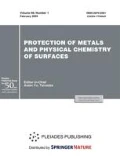Abstract
Residual inhibition coefficients K t of acidic corrosion by a mixture of an organic inhibitor and an anionic additive for Al, Zn, Fe, and Ni decrease linearly in time; the duration of the residual protective effect depends linearly on the logarithm of the anionic additive concentration in the preadsorption solution. The effect of anions on the values of K t and τ for the studied mixtures is determined by the nature of the metal and anion. It is established on the basis of Pearson’s principle of hard and soft acids that the K t and τ values grow upon an increase in the organic inhibitor concentration in preadsorption solutions, irrespective of the nature of the metal.
References
Grigor’ev, V.P., Shpan’ko, S.P., Boginskaya, V.V., and Plekhanova, E.V., Prot. Met. Phys. Chem. Surf., 2010, no. 1, p. 88.
Shpan’ko, S.P., Gpigop’ev, V.P., Plekhanova, E.V., and Anisimova, V.A., Korroz.: Mater., Zashch., 2009, no. 8, p. 34.
Damaskin, B.B., Petrii, O.A., and Batrakov, V.V., Adsorbtsiya organicheskikh soedinenii na elektrodakh (Adsorption on Organic Electrodes), Moscow: Nauka, 1968.
Pirson, R.Dzh., Usp. Khim., 1971, vol. 40, no. 2, p. 1229.
Miskidzh’yan, S.P. and Garnovskii, A.D., Vvedenie v sovremennuyu teoriyu kislot i osnovanii (Introduction into Modern Theory of Acids and Bases), Kiev: Golovnoe izd-vo ob’edineniya “Vishcha shkola”, 1979.
Kuznetsov, Yu.I., Zashch. Met., 1994, vol. 30, no. 4, p. 341.
Kuznetsov, Yu.I., Zashch. Met., 1995, vol. 31, no. 3, p. 229.
Kuznetsov, Yu.I., Zashch. Met., 1997, vol. 33, no. 2, p. 117.
Pogrebova, I.S., in Fiziko-khimicheskie osnovy deistviya ingibitorov korrozii metallov (Physico-Chemical Fundamentals of Effect of Metal Corrosion Inhibitors), Moscow: IFKh AN SSSR, 1989, p. 23.
Grigor’ev, V.P., Bartenev, V.V., Barteneva, O.I., and Gontmakher, N.M., Zashch. Met., 1992, vol. 28, no. 2, p. 298.
Grigor’ev, V.P. and Boginskaya, V.V., Zashch. Met., 2006, vol. 42, no. 5, p. 520.
Grigor’ev, V.P. and Boginskaya, V.V., Zashch. Met., 2006, vol. 42, no. 6, p. 627.
Grigor’ev, V.P., Kravchenko, V.M., and Gershanova, I.M., Zashch. Met., 2004, vol. 40, no. 3, p. 236.
Author information
Authors and Affiliations
Corresponding author
Additional information
Original Russian Text © V. P. Grigor’eva, S. P. Shpan’koa, E. V. Plekhanovaa, A. S. Burlovb, and V. A. Anisimovab, published in Korroziya: Materialy, Zashchita, 2011, No. 4, pp. 39–43.
Rights and permissions
About this article
Cite this article
Grigor’ev, V.P., Shpan’ko, S.P., Plekhanova, E.V. et al. Application of Pearson’s principle to interpretation of the duration of the residual protective effect of organic inhibitors as a function of the nature of a metal and anion. Prot Met Phys Chem Surf 48, 764–768 (2012). https://doi.org/10.1134/S2070205112070064
Received:
Published:
Issue Date:
DOI: https://doi.org/10.1134/S2070205112070064

